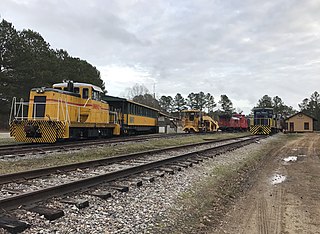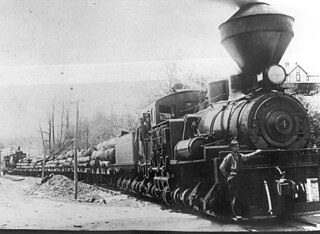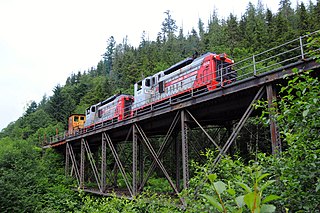
The Shay locomotive is a geared steam locomotive that originated and was primarily used in North America. The locomotives were built to the patents of Ephraim Shay, who has been credited with the popularization of the concept of a geared steam locomotive. Although the design of Ephraim Shay's early locomotives differed from later ones, there is a clear line of development that joins all Shays. Shay locomotives were especially suited to logging, mining and industrial operations and could operate successfully on steep or poor quality track.

The Oahu Railway and Land Company, or OR&L, was a 3 ft narrow gauge common carrier railway that served much of the Hawaiian island of Oahu, and was the largest narrow gauge class one common carrier in the U.S, until its dissolution in 1947.

The Central of Georgia Railway started as the Central Rail Road and Canal Company in 1833. As a way to better attract investment capital, the railroad changed its name to Central Rail Road and Banking Company of Georgia. This railroad was constructed to join the Macon and Western Railroad at Macon, Georgia, in the United States, and run to Savannah. This created a rail link from Chattanooga, on the Tennessee River, to seaports on the Atlantic Ocean. It took from 1837 to 1843 to build the railroad from Savannah to the eastern bank of the Ocmulgee River at Macon; a bridge into the city was not built until 1851.

The Washington and Old Dominion Railroad was an intrastate short-line railroad located in Northern Virginia, United States. The railroad was a successor to the bankrupt Washington and Old Dominion Railway and to several earlier railroads, the first of which began operating in 1859. The railroad closed in 1968.

Cass Scenic Railroad State Park is a state park and heritage railroad located in Cass, Pocahontas County, West Virginia.
The Wilmington and Western Railroad is a freight and heritage railroad in northern Delaware, operating over a former Baltimore and Ohio Railroad (B&O) branch line between Wilmington and Hockessin. The 10.2-mile (16.4 km) railroad operates both steam and diesel locomotives. It was added to the National Register of Historic Places as a national historic district in 1980. Wilmington & Western serves one customer for revenue service, and interchanges with CSX Transportation at Landenberg Junction, Delaware

The Yosemite Mountain Sugar Pine Railroad (YMSPRR) is a historic 3 ft narrow gauge railway with two operating steam locomotives located near Fish Camp, California, in the Sierra National Forest near the southern entrance to Yosemite National Park. Rudy Stauffer organized the YMSPRR in 1961, utilizing historic railroad track, rolling stock and locomotives to construct a tourist line along the historic route of the Madera Sugar Pine Lumber Company.

The Chelatchie Prairie Railroad is a heritage railroad in Yacolt, Washington. Formerly a Northern Pacific branchline and operated by the Longview, Portland and Northern Railway for many years, in the 1980s and 1990s the line went through a number of successive operators. Today the railroad is owned by Clark County, Washington, and the trackage from Vancouver Junction to Heisson is operated by the Portland Vancouver Junction Railway for freight traffic. No freight traffic exists north of Battle Ground at this time.

The New Hope Valley Railway is a heritage railroad in Bonsal, North Carolina operated by the North Carolina Railway Museum, Inc., an all-volunteer, nonprofit, and tax exempt educational and historical organization.

The White Top Railway was chartered as a common carrier in the early 20th century from a portion of the logging lines of the Hassinger Lumber Company in Washington and Grayson Counties, Virginia, United States. The move was born of the lumber company's need to protect its rail operations at points of intersection with the Virginia-Carolina Railway from possible condemnation for the V-C's own, expanding line.

Silver City, Pinos Altos and Mogollon Railroad was a 2 ft narrow gauge railway serving copper mines along the Continental Divide in the mountains of southwestern New Mexico. The communities of Silver City and Pinos Altos developed as 19th century miners recovered easily extracted gold and silver from ore deposits of the area. Standard-gauge Santa Fe Railroad reached Silver City in 1886, and SC, PA&M was incorporated 24 August 1889 to build a railway north to Mogollon, New Mexico. Construction was limited to 5 miles (8.0 km) of grading until Wisconsin-based Comanche Mining and Smelting purchased the railroad and the Pinos Altos mining claims of George Hearst in 1903 after horse-drawn ore transport became uneconomical. The Silver City smelter burned shortly after purchase, but was rebuilt with three blast furnaces and a reverberatory furnace to handle 225 tons of ore per day. Two Shay locomotives were moved to Silver City in August 1905 from the Gilpin tramway of Gilpin County, Colorado. The railroad was built through iron and limestone mines on Chloride Flat west of Silver City. The limestone was used as a flux for smelting the copper ore.
The Simpson Investment Company is a company based in McCleary, Washington in the US Pacific Northwest that specializes in manufacture of forest products. Founded as a logging company in 1890 by Sol Simpson, the company now functions as a holding company for the Simpson Door Company, a manufacturer of wood doors.

The Railroad Museum of Oklahoma is a railroad museum located in the former Atchison, Topeka and Santa Fe Railway freight depot in Enid, Oklahoma. The museum began in 1977 and is a non-profit operated by the Enid chapter of the National Railway Historical Society. The freight depot was listed on the National Register of Historic Places in 2015.
The Caspar, South Fork & Eastern Railroad provided transportation for the Caspar Lumber Company in Mendocino County, California. The railroad operated the first steam locomotive on the coast of Mendocino County in 1875. Caspar Lumber Company lands became Jackson Demonstration State Forest in 1955, named for Caspar Lumber Company founder, Jacob Green Jackson.

Englewood Railway was a logging railroad on northern Vancouver Island, Canada. Headquartered in Woss, British Columbia, the line ran 90 km (56 mi) from Vernon Lake, through Woss, and past Nimpkish Lake Provincial Park to Beaver Cove. It was the last operating logging railroad in North America. After 100 years of use, railway operations ceased on November 7, 2017, following a deadly derailment in April of that year.

The Nahma and Northern Railway Locomotive #5 is a locomotive located at the corner of Main Street and River Street in Nahma Township, Michigan.
The Mason and Oceana Railroad (M&O) was a short common carrier, 3 ft narrow gauge logging railroad in the U.S. state of Michigan. Organized in 1887 and in operation from 1887 until 1909, it served the counties of Mason and Oceana in the northwestern quarter of Michigan's Lower Peninsula in the late 19th and early 20th centuries.

The Vance Creek Bridge is an arch bridge in the Satsop Hills of Mason County, Washington that was built for a logging railroad owned by the Simpson Logging Company in 1929. At 347 feet (106 m) in height, it is the second-highest railroad arch in the United States after the nearby High Steel Bridge. It was decommissioned in the 1970s, during the decline of logging on the Olympic Peninsula.

The Madera Sugar Pine Company was a United States lumber company that operated in the Sierra Nevada region of California during the late 19th and early 20th centuries. The company distinguished itself through the use of innovative technologies, including the southern Sierra's first log flume and logging railroad, along with the early adoption of the Steam Donkey engine. Its significant regional impact led to the establishment of towns such as Madera, Fish Camp, and Sugar Pine, as well as the growth of Fresno Flats and the formation of Madera County.

















